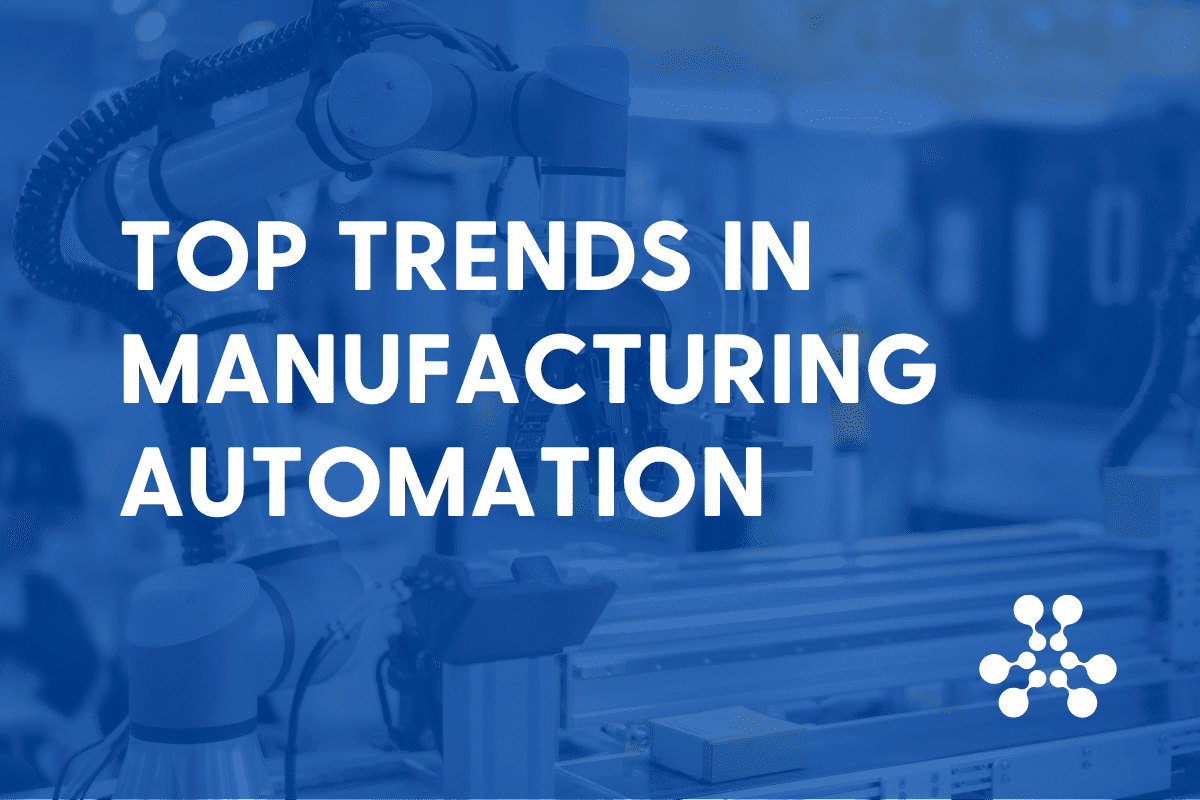Topics of interest
Manufacturing automation continues to advance at a breakneck pace. Technological innovations fuel much of that progress, but automation in manufacturing goes far beyond robotic assembly lines and additive manufacturing. Modern manufacturers have accelerated digitalization efforts, increased data collection and analysis investments, adopted artificial intelligence (AI) and Internet of Things (IoT) solutions, and more. These Industry 4.0 and Smart Manufacturing efforts have enabled huge leaps in efficiency, productivity, quality, speed, cost reductions, and other critical metrics via automation in manufacturing.
So, what is manufacturing automation, and how can you leverage it to improve growth at your manufacturing company? Along with information from researchers, analysts, and industry thought leaders, we used findings from our most recent “State of Manufacturing Technology Survey” of more than 500 manufacturers to better understand the top trends around automation in manufacturing.
Let’s dive in!
What is Manufacturing Automation?
While today’s manufacturing automation can be very advanced, it all springs from the original forms of manufacturing automations throughout history especially in the early days of the Industrial Revolution. Waterwheels used to grind grain more than two thousand years ago are generally considered the first forms of manufacturing automation. Fast forward a thousand years, and waterwheels and windmills were adapted to automate hammers, saws, crushing, and other machinery. Then, from the 17th century through to today, steam engines, gas engines, electrification, and computers quickly brought us to our current and still-advancing concepts of automation in manufacturing.
Today, automation in manufacturing takes many forms. Because manufacturing automation is a broad term, it is typically segmented into fixed, programmable, and flexible automation.
- Fixed automation in manufacturing is hardware or machinery that completes a specific task in high volumes and is not easily adapted to other tasks. An example would be machinery that creates a specific metal stamping.
- Programmable automation in manufacturing is more adaptable, and output can be switched over as batches or production needs change, but with associated downtime. An example would be CNC machines easily reprogrammed to produce different parts—even within the same production run.
- Flexible automation in manufacturing is programmable for quick adaptations with extremely short downtime and even remotely. Modern manufacturing assembly lines and material handling systems are designed in this manner. Examples include painting and welding processes.
But automation extends to business processes, too. Manufacturers continue to automate processes across the business, such as:
- Repetitive tasks on the production line and in the back office,
- Machine monitoring, management, and maintenance,
- Sales and marketing tasks,
- Financial, billing, and other revenue-related functions,
- Quality assurance and testing,
- Quote-to-cash processes,
- Reporting and data analysis,
- And so much more!
Top Trends & Use Cases for Automation in Manufacturing
Manufacturing automation technologies are advancing as fast as every other technology. Solution providers are bringing more AI and generative AI technology to help automation in manufacturing quickly adjust, learn, and adapt to changing needs. However, the core requirement to run an efficient, competitive business will never change.
In our “State of Manufacturing Technology Survey,” we found that more than one-third of manufacturers remain concerned about unreliable supply chains and decreasing business demand. For manufacturers looking to invest in automation, many survey respondents cite resource constraints (31%) and time (27%) as the primary obstacles to digital transformation efforts.
However, to run an efficient, competitive business, manufacturers say they continue to focus on enhancing operational and production performance (41%) and cost reductions (30%). That likely contributes to 51% of manufacturers saying they are increasing investments in enterprise software. This spending also comes with a proven ROI, as 56% say technology helped them reduce costs, and 46% say it enhanced business agility and resiliency.
Additional trends impacting manufacturers and automation in manufacturing specifically include the following.
Manufacturing Labor Constraints
While the current labor shortage in the manufacturing industry has fluctuated between 500,000 – 600,000 unfilled jobs, Deloitte says that U.S. manufacturers expect to have 2.1 million unfilled jobs by 2030. Automation can help fill much of this gap. Ironically, automation is expected to create 97 million new “jobs of tomorrow” that will also need to be filled, according to “The Future of Jobs Report” from the World Economic Forum.
The Need for Speed
Customers want more choices delivered in less time, which increases the pressure on manufacturers to accelerate operations, design, production, supply chains, billing, and every other aspect of business. Blame Amazon all you want, but automation—including automated logistics capabilities—is key to accelerating business and manufacturing processes.
Industry 4.0 and Smart Manufacturing
Industry 3.0 brought more computers into the manufacturing realm, and now those computers are being connected and advanced in Industry 4.0 to broaden insights, improve human decision-making, and even make decisions without humans. This evolution to Smart Manufacturing provides the foundation for intelligent factories that get smarter as they acquire more data, resulting in greater efficiency, productivity, and quality with less waste.
Just like AI, Smart Manufacturing is a fast-moving trend. Recent research shows that the global smart factory software market will exceed $97 billion by 2028. Whether or not you are adopting these technologies, your competitors likely are.
Advancements in AI for Manufacturers
AI and generative AI have reached peak hype, but the technology is already proving valuable across business and manufacturing processes. Generative AI is helping sales and marketing drive more revenue with customized content quickly generated that increases individual productivity in every department. AI gives business, operations, and production decision makers faster access to more accurate plans and forecasts. Related AI technologies like machine learning are adding intelligence to manufacturing automation that enables machinery and software to learn and improve based on experiences and outcomes.
In our “State of Manufacturing Technology Survey,” 90% of manufacturers use some form of AI in their operations. However, 38% feel they are behind competitors in AI implementation and progress.
>> Learn more about how AI is revolutionizing efficiency for manufacturers.
Digital Twins and Simulation Technologies
Upstream of production sits your engineers, product managers, marketers, and others who develop, test, and launch new products. But, as your customers demand more options delivered in less time, manufacturers must accelerate product development efforts. Similarly to the trends listed above, AI and new technologies are digitizing and automating manufacturing product development.
Digital twins are virtual representations of physical objects that simulate the desired functionality, can respond to empirical measurements taken on a physical device, and can refine designs faster than traditional, manual methods. The digital twins process thus automates efforts to optimize production and product performance, increase production efficiency, improve product lifecycles and maintenance needs, and more, all without requiring human intervention.
Accenture says that digital twins “drive faster time to value at a lower cost,” which increases manufacturing automation’s overall return on investment. Many manufacturers are adopting digital twin technology, so much so that McKinsey expects the global market for digital twin technology to grow 60% per year through 2027.
The Internet of Things (IoT) Integration
IoT can be traced back to the 1980s, which makes it a decidedly ancient concept in terms of technology. However, today’s Industrial IoT (IIoT) remains a key manufacturing automation component that continues to grow as it incorporates new technologies. Even today, IoT spending increases at a 17% annual rate and is a top-three corporate technology priority.
So, what is IIoT? It’s any network of devices, vehicles, machinery, sensors, and other objects connected to collect and share data. Manufacturing automation can use IoT data to optimize production processes, improve decision-making, manage resources, reduce costs, and enhance efficiency. Also, IIoT devices can be used to automatically calibrate machinery, monitor quality during production, reduce energy consumption, track goods, and request maintenance.
Manufacturing Automation for Sustainability
Manufacturers consume vast amounts of energy, water, raw materials, and other resources while accounting for 30% of greenhouse gas emissions in the U.S. However, nearly every application of manufacturing automation contributes to sustainability and green manufacturing.
Robotics and operational automation can reduce energy and resource consumption. Automation can identify quality issues quickly and during production to eliminate waste and rework. IoT sensors can automatically alert teams to water leaks, excess energy consumption, and other wasteful scenarios. Inventory automation can streamline supply chains and logistics to reduce materials movements, automate inventory management, minimize inventory obsolescence, and reduce wasted time and fuel.
Beyond sustainability and energy efficiency, manufacturers can turn these efforts into a competitive advantage to reach new customers, reduce operational costs, and build long-term business viability.
Benefits of Manufacturing Automation
The many trends listed above show that manufacturing automation is necessary for today’s manufacturers, regardless of size or sector. The business basics of competitiveness, efficiency, and productivity combined with the need to combat labor constraints, increasing demand for speed, and your competitors’ adoption of advanced technologies can all be achieved through manufacturing automation.
To summarize, some of the benefits of automation in manufacturing include:
Increased efficiency
Manufacturing automation increases efficiency through streamlined processes, reduced manual labor, fewer human errors, and faster production cycles.
Cost savings
Automation in manufacturing boosts cost savings through increased worker productivity, elimination of repetitive tasks, optimization of physical resources, reduced waste and rework, and more.
Improved product quality
Manufacturing automation improves product quality by removing the possibility of human errors to drive greater consistency and repeatability, thus reducing defects.
More effective decision-making
Automation in manufacturing enables more effective decision-making through more accurate, up-to-date information and insights that can be used to create better production plans, forecasts, and business strategies.
Increased scalability
Manufacturing automation increases scalability with production management automation that can handle higher volumes for greater cost advantages and process automation that can enable human workers to do more in less time. This allows manufacturers to “do more with same” and grow their business without an equivalent increase in workers.
Improved safety
Automation in manufacturing improves safety by removing humans from dangerous tasks, eliminating tedious or boring tasks, and providing automated alerts to hazardous situations.
Enhanced competitiveness
Manufacturing automation enhances competitiveness through faster product development cycles, higher product quality, more cost-efficient production and operations, and more and better data-driven insights to improve customer experiences and satisfaction.
How Rootstock Uses AI for Manufacturers
Rootstock manufacturing cloud ERP enables enhanced manufacturing automation with AI from Rootstock, or AIRS, our revolutionary AI-based solution designed to transform manufacturing decisions. It uses predictive and generative AI power to help manufacturers of all sizes and sectors automate production and operational processes for faster decisions, fewer errors, and, ultimately, better business results.
Rootstock AIRS
To enable effective automation in manufacturing, you need signals from across the business to inform and guide automated processes intelligently. But, most manufacturers have disconnected silos of systems and data, making the transition to Industry 4.0 and manufacturing automation difficult.
Rootstock AIRS is built on the Salesforce Einstein 1 and Data Cloud platforms and uses our unique ERP dataset that covers order, supply, financial, and production data consolidated from across your manufacturing signal chain of CRM, SCM, PLM, IoT platforms, and other systems. AIRS can recalculate projections and enable dynamic adjustments to your order-to-cash, procure-to-pay, and plan-to-produce processes in response to incoming signals.
You can use AIRS’ predictive and generative AI for:
- Inventory Planning and Next-Generation MRP to predict lead times, foresee production bottlenecks, allocate materials and resources more accurately, and reduce waste.
- Demand Forecasting to predict sales trends and new opportunities so sales teams can focus on initiatives more likely to improve revenue.
- Supplier Collaboration and Risk Management to better identify opportunities for savings and sourcing strategies.
- Financials/Cash Flow Forecasting for deeper insights into your business’s financial health.
- Generative AI for Enhanced Communication to streamline the creation of dunning letters and revolutionize customer communications with personalized, scalable interactions.
Click here to learn more about Rootstock AIRS.






